
Baggensgatan
Encyclopedia
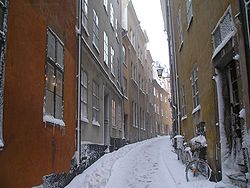
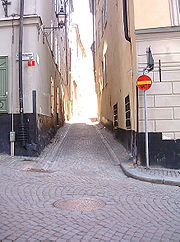
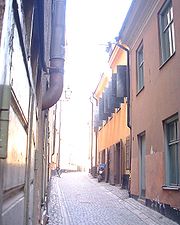
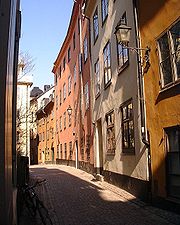
Street
A street is a paved public thoroughfare in a built environment. It is a public parcel of land adjoining buildings in an urban context, on which people may freely assemble, interact, and move about. A street can be as simple as a level patch of dirt, but is more often paved with a hard, durable...
in Gamla stan
Gamla stan
Gamla stan , until 1980 officially Staden mellan broarna , is the old town of Stockholm, Sweden. Gamla stan consists primarily of the island Stadsholmen. The surrounding islets Riddarholmen, Helgeandsholmen, and Strömsborg are officially part of, but not colloquially included in, Gamla stan...
, the old town in central Stockholm
Stockholm
Stockholm is the capital and the largest city of Sweden and constitutes the most populated urban area in Scandinavia. Stockholm is the most populous city in Sweden, with a population of 851,155 in the municipality , 1.37 million in the urban area , and around 2.1 million in the metropolitan area...
, Sweden
Sweden
Sweden , officially the Kingdom of Sweden , is a Nordic country on the Scandinavian Peninsula in Northern Europe. Sweden borders with Norway and Finland and is connected to Denmark by a bridge-tunnel across the Öresund....
. Forming a southern extension to the street Bollhusgränd
Bollhusgränd
Bollhusgränd is an alley in Gamla stan, the old town in central Stockholm, Sweden. Named after Bollhuset, a historical theatre, it connects Slottsbacken to Köpmantorget, and as Baggensgatan extends the alley further south beyond Köpmangatan, together they form a parallel street to Österlånggatan...
near the square Köpmantorget
Köpmantorget
Köpmantorget is a small public square in Gamla stan, the old town in central Stockholm, Sweden, located between the street Köpmangatan and to slopes collectively named Köpmanbrinken, both of who leads down to the street Österlånggatan...
, it stretches to the southern end of Svartmangatan. It forms a parallel street to Själagårdsgatan
Själagårdsgatan
Själagårdsgatan is a street in Gamla stan, the old town in central Stockholm, Sweden. Stretching south from Köpmangatan to Tyska Brunnsplan, it forms a parallel street to Baggensgatan...
and Österlånggatan
Österlånggatan
Österlånggatan is a street in Gamla stan, the old town of Stockholm, Sweden. Stretching southward from Slottsbacken to Järntorget, it forms a parallel street to Baggensgatan and Skeppsbron...
, while being intercepted by Tyska Skolgränd
Tyska Skolgränd
Tyska Skolgränd is an alley in Gamla stan, the old town in central Stockholm, Sweden, stretching from Svartmangatan to Baggensgatan, and crossed by Själagårdsgatan....
.
Origin of the name
Appearing in historical records as Jakob Baggæs gathe in 1596, the street was named after the then admiral Jakob Bagge (1502-1577) (later governor at the Royal PalaceStockholm Palace
The Stockholm Palace is the official residence and major royal palace of the Swedish monarch. . Stockholm Palace is located on Stadsholmen , in Gamla Stan in the capital, Stockholm...
) who was given a lot by King Gustav Vasa
Gustav I of Sweden
Gustav I of Sweden, born Gustav Eriksson of the Vasa noble family and later known simply as Gustav Vasa , was King of Sweden from 1523 until his death....
at number 30 in 1536. It is mentioned as Baggenss gatu 1638.
History
Together with BollhusgrändBollhusgränd
Bollhusgränd is an alley in Gamla stan, the old town in central Stockholm, Sweden. Named after Bollhuset, a historical theatre, it connects Slottsbacken to Köpmantorget, and as Baggensgatan extends the alley further south beyond Köpmangatan, together they form a parallel street to Österlånggatan...
, Baggensgatan formed a thoroughfare passing just inside the eastern city wall, just like Prästgatan
Prästgatan
Prästgatan is a street in Gamla stan, the old town in central Stockholm, Sweden, stretching from a cul-de-sac west of the Royal Palace to the street Österlånggatan in the southern corner of the old town. Prästgatan forms a parallel street to Västerlånggatan, Trångsund, Skomakargatan, and...
passed just inside the western wall. The difference in altitude between these thoroughfares and those who passed just outside the city walls, is biggest between Österlånggatan and Baggensgatan, almost ten metres. In the southern end, the lowest section of the street, was the Blackfriars monastery.
Notable buildings
On Number 14 lived the opera diva Elisabeth OlinElisabeth Olin
Elisabeth Olin was a Swedish opera singer and a music composer. She is referred to as the first Swedish Opera prima donna. She was a court-singer . She was the first female member of the Royal Swedish Academy of Music...
, at the age of 33 she became the first prima donna
Prima donna
Originally used in opera or Commedia dell'arte companies, "prima donna" is Italian for "first lady." The term was used to designate the leading female singer in the opera company, the person to whom the prime roles would be given. The prima donna was normally, but not necessarily, a soprano...
at the inauguration of the opera of King Gustav III
Gustav III of Sweden
Gustav III was King of Sweden from 1771 until his death. He was the eldest son of King Adolph Frederick and Queen Louise Ulrica of Sweden, she a sister of Frederick the Great of Prussia....
on January 18, 1773. Her voice was described as supernatural and though she retired from singing after ten years, she is said to have kept her beauty until her death at the age of 87.
The building on Number 23 was known as Ahlströms jungfrubur ("The Maiden Cage of Ahlström"). It was bought in 1762 by a captain Magnus Ahlström who is described as having created a "virtual temple of Venus with space for the priestesses on all three floors". Though the brothel made Ahlström rich, it often resulted in squads of prostitutes spending time at the Långholmen prison
Långholmen prison
Långholmen Prison, officially Långholmen Central Prison , was historically one of the biggest prison facilities in Sweden with more than 500 cells, located on the island of Långholmen in Stockholm. It was built 1874-1880 as the central prison of Sweden, and was in use until 1975...
while all the taverns and other brothels gave the street a bad reputation for a long time.
The building on Number 25 use to be a stable, the shutters were the only thing protecting the horses from the harsh Swedish winters.
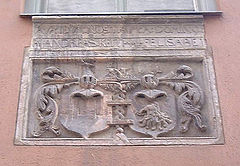
Coat of arms
A coat of arms is a unique heraldic design on a shield or escutcheon or on a surcoat or tabard used to cover and protect armour and to identify the wearer. Thus the term is often stated as "coat-armour", because it was anciently displayed on the front of a coat of cloth...
of Scotch Anders Keith and his wife who lived in the building in the end of the 16th century when he served King John III
John III of Sweden
-Family:John married his first wife, Catherine Jagellonica of Poland , house of Jagiello, in Vilnius on 4 October 1562. In Sweden, she is known as Katarina Jagellonica. She was the sister of king Sigismund II Augustus of Poland...
. He sold the building to Sigismund of Sweden and Poland
Sigismund III Vasa
Sigismund III Vasa was King of Poland and Grand Duke of Lithuania, a monarch of the united Polish–Lithuanian Commonwealth from 1587 to 1632, and King of Sweden from 1592 until he was deposed in 1599...
, who, wanting to reintroduce Catholicism in Sweden, used it as a presbytery and a chapel, a failed propaganda campaign which gave the building the name Paptistkyrkan ("The Papist Church").
In culture
The troubadour Carl Michael BellmanCarl Michael Bellman
was a Swedish poet and composer. Bellman is a central figure in the Swedish song tradition and remains a very important influence in Swedish music, as well as in Scandinavian literature in general, to this day....
(1740-1795) dedicated one of his songs to Baggensgatan:
- Sång 54 : Mollberg höll flaskan - Om Baggensgatan
- Song 54 : Mollberg held the bottle - About Baggensgatan
The song gives a burlesque description of the alley, detailing maidens nodding in every corner, buildings filled with girls up to the attic busy sharing songs, kisses, and beds. The song ends: Släck ljuset! Nu ä Lotta min. / "Turn off the light! Now, Lotta is mine."

